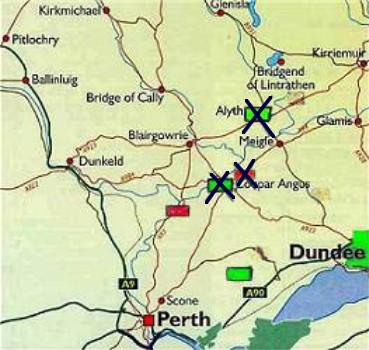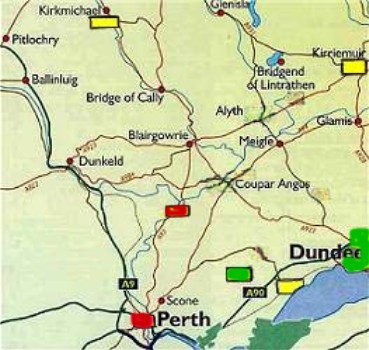Did the Industrial Revolution change where the Wighton families lived? The short answer to the question is Yes, definitely! I'll show that to you visually. Below, you'll see two maps. You've already seen the map on the left. It shows the 4 biggest population centers up to 1725 in green and three smaller centers in red. The map on the right shows where Wightons primarily lived after 1725.


In the Pre-Industrial Revolution map above, I've drawn Xs through three of these centers - Coupar Angus, Kettins, and Alyth - since the Wightons did not stay in these towns once the Industrial Revolution began.
Now look at the map above on the right - it represents where Wightons lived DURING the Industrial Revolution. Only Perth and Cargill (in red) and Kinnaird and Dundee (in green) remain from the pre-Industrial Revolution map. Three new centers have been added in yellow. In the north are Kirkmichael and Kirriemuir, and next to the Tay River is Errol. Wightons were also found in abundance in Glasgow and Edinburgh but I couldn't show them in the map without making a severe change in the scale. (Edinburgh is about 30 miles due south of Dundee. Glasgow is about 40 miles south-west of Perth.)
Look again at the two maps, but this time focus only on the distribution of the towns. In the pre-Industrial Revolution map, there's a healthy presence in the agriculturally rich Strathmore Valley in the center of the map. But, after the Industrial Revolution began, this agricultural heartland was empty except for one red town - Cargill. Every other Wighton center was on the periphery of the map - especially if you consider Edinburgh and Glasgow.
So, it's apparent that one of the first consequences of the Industrial Revolution was to significantly reduce the Wighton populations in the center of Perthshire/Angus and redistribute our presence to the four urban centers in southern Scotland (Perth, Dundee, Glasgow, Edinburgh) as well as to some outlying agricultural areas. Our top 9 population centers during the industrial revolution are listed in order and then linked to further descriptions.
Dundee remains our #1 city. You'll recall that it was our biggest center prior to 1725 with about 80 Wightons, but, during the Industrial revolution, our presence quadrupled in the city. (Of course, the city's population itself grew even more.) With about 350 Wightons in the city between 1725 and 1850, Dundee had 6 times the number of Wightons found in the next largest center.
Wighton Families in Dundee: Part 2
Cargill represents not only our second biggest population center during the Industrial Revolution, it was also our second largest population center for the entire period of 1600 - 1850. You can see on the map that the village was situated south-west of Coupar Angus and north of Perth in the Strathmore Valley - prime agricultural land. Although a small Wighton presence could be hypothesized in the early 1600s, the number of Wightons in Cargill only started to grow in the early 1700s. Unlike the other agricultural towns of Alyth, Kettins, and Coupar Angus, Cargill kept its Wighton families during the second half of the 18th century. In all, between 1700 and 1810, 67 Wightons would be born/married in Cargill. However, after 1810, there were no births. Since the Industrial Revolution did not stop after 1810, we must look for other reasons why Cargill would appeal to so many Wightons and then suddenly become so unattractive.
To get to our third largest center, we have to leave Cargill and travel about 50 miles southwest to Glasgow. We have no record of any Wightons in Glasgow (and surrounding communities) until 1778. From that point onward, there was a Wighton presence in the city through to the 1850s (when my research ended). In all, 42 Wightons lived in the city. Unlike Cargill, Glasgow was a true Industrial Revolution city and it grew increasingly more important to Scotland's economy through the 1800s. As such, it is not surprising that Wightons remained in the city.
Since we're already in southern Scotland, let's travel about 40 miles east to Edinburgh, our fourth largest center during the Industrial Revolution with 41 Wightons. Unlike Glasgow, there was an early Wighton presence in Scotland's capital city with 13 Wightons born/married between 1600 and 1700. After an interregnum of about 75 years, the Wightons returned to Edinburgh during the Industrial Revolution and their presence remained to the end of my research period.
Let's head back north again and visit Perth, our fifth largest center during the Industrial Revolution. At least five Wichtouns/Wigtones were born in the city before 1600. However, our early presence dissipated soon afterwards. During the Industrial Revolution, the city attracted workers from the surrounding countryside and 39 Wightons were part of that influx. Perth's vitality gradually diminished after 1800, as did the Wighton presence.
Our sixth largest Industrial Revolution center (38 Wightons) is Errol, a small town on the Tay River about halfway between Perth and Dundee. Whereas nearby Kinnaird had been a significant center prior to 1725, it had lost most of its Wightons by 1775. Errol had a relatively steady population of Wightons between 1750 and 1850. And yet, Errol was completely devoid of industry that would attract farmers driven off their lands.
Before we leave south Perthshire, let's skip our 7th largest center and travel a few miles north of Errol to our 8th largest center - Kinnaird. You've already read about Kinnaird in the Pre-Industrial Revolution pages - it was our third largest center prior to 1725. Wighton families remained in this parish in large numbers between 1725 and 1750, however only two families remained after that date. Ten children were raised in the next generation, but by 1775, the Wightons had left the parish. Kinnaird was a significant town for us. It had 39 Wightons prior to 1725 (#3), and enough remained in the area during the first stages of the Industrial Revolution to give it a #8 ranking. However, it was a purely agricultural area and the Lowland Clearances put an end to our presence there. The histories linked below are the same as what I had in the pre-Industrial Revolution pages. If you have already read those, you may want to skip to the next town.
We have to take a long hike to find our seventh largest population center. Kirkmichael is located in the Scottish highlands, at least 15 miles north-west of Alyth. This location in poor farming country is somewhat unusual for the Wighton family with a long history of farming in the fertile lands of the Lowlands. In spite of this, Kirkmichael had a reasonably large presence of Wightons from 1725 to 1825.
Wighton Families in Kirkmichael
Our ninth, and last, Industrial Revolution center is Kirriemuir which, like Dundee, is in Angus. Kirriemuir is in the northwest corner of Angus which puts it a considerable distance northeast of Alyth. Kirriemuir's location near the highlands might lead you to think that Wighton farmers were drawn there for the same reason that they were attracted to Errol and Kirkmichael, namely the opportunity to continue to lease small farms for reasonable rents. However, Kirriemuir's landowners had already begun to implement agricultural improvements (i.e., new leases) when the first Wightons arrived. The Lowland Clearances were already in full force and small farms with low rents were unlikely to be found. And yet, Kirriemuir certainly attracted its Wightons from outside - there was no Wighton presence in the parish before 1767. You'll have to read the histories to discover the attraction.
Wighton Families in Kirriemuir
We've now looked at the Wighton population centers both before and during the Industrial Revolution. If you're interested, here are how the eight largest centers rank in size for the entire research period - from 1600 to 1850.
Dundee area: 431
Cargill: 82
Alyth: 78
Kinnaird: 72
Perth: 55
Edinburgh: 54
Errol: 52
Glasgow: 42
Sources
Various web sites, including:
Family Search: The Latter Day Saints Database (http://www.familysearch.org)
ScotlandsPeople Database (http://www.scotlandspeople.gov.uk/)